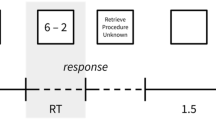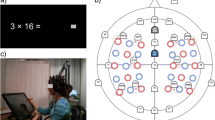Abstract
Mathematical problem solving is an explicitly formed skill formed during school education. The goal of the work was to study cognitive event-related potentials (ERPs) in solving mathematical equations (addition, subtraction) in adolescents (12–16 years of age) living in different regions of northern Russia: Arkhangelsk (n = 14) and Murmansk (non-Sami, n = 17; Sami, n = 13) regions. The subjects were asked to solve delayed answer verification tasks: the trial consisted of two stimuli: the trial started with presenting a problem for 400 ms; then, after 700 ms, an answer was presented, either correct or incorrect one. The subjects had to press the left mouse button at correct answer. Differences in the ERP amplitude were observed at the interval of 220–270 ms after presentation of the first stimulus due to shorter P2–N3 complex latency in adolescents from the Circumpolar region as compared with adolescents from the Polar region. Differences in the amplitudes of the late positive component at the interval of 430–530 ms were also observed (greater values were observed in the Sami adolescents). Differences between the groups were observed at presentation of a correct solution and were characterized by the greater latency of the negative ERP component in frontal, central, and parietal areas in the adolescents living in the Polar region. Thus, the characteristics of the ERP components during mathematical problem solving show differences probably related to the regional aspects of development in children.

Similar content being viewed by others
REFERENCES
Robinson, K.M., Arbuthnott, K.D., Rose, D., et al., Stability and change in children’s division strategies, J. Exp. Child Psychol., 2006, vol. 93, no. 3, p. 224.
Roussel, J.L., Fayol, M., and Barrouillet, P., Procedural vs. direct retrieval strategies in arithmetic: A comparison between additive and multiplicative problem solving, Eur. J. Cognit. Psychol., 2002, vol. 14, no. 1, p. 61.
Thevenot, C., Castel, C., Danjon, J., and Fayol, M., Identifying strategies in arithmetic with the operand recognition paradigm: a matter of switch cost? J. Exp. Psychol. Learn. Mem. Cognit., 2015, vol. 41, no. 2, p. 541.
Hsu, Y.F. and Szücs, D., Arithmetic mismatch negativity and numerical magnitude processing in number matching, BMC Neurosci., 2011, vol. 12, no. 83. https://doi.org/10.1186/1471-2202-12-83
Jost, K., Hennighausen, E., and Rösler, F., Comparing arithmetic and semantic fact retrieval: effects of problem size and sentence constraint on event-related brain potentials, Psychophysiology, 2004, vol. 41, no. 1, p. 46.
Niedeggen, M. and Rösler, F., N400 effects reflect activation spread during retrieval of arithmetic facts, Psychol. Sci., 1999, vol. 10, no. 3, p. 271.
Niedeggen, M., Rösler, F., and Jost, K., Processing of incongruous mental calculation problems: Evidence for an arithmetic N400 effect, Psychophysiology, 1999, vol. 36, no. 3, p. 307.
Jasinski, E.C. and Coch, D., ERPs across arithmetic operations in a delayed answer verification task, Psychophysiology, 2012, vol. 49, no. 7, p. 943.
Menon, V., Rivera, S.M., White, C.D., et al., Dissociating prefrontal and parietal cortex activation during arithmetic processing, NeuroImage, 2000, vol. 12, no. 4, p. 357.
Shemyakina, N.V., Nagornova, Z.V., Pryanichnikov, S.V., and Soroko, S.I., Passive perception of auditory stimuli in healthy and mild mentally retarded adolescents from Northern Russia, Hum. Physiol., 2016, vol. 42, no. 2, p. 137.
Shemyakina, N.V., Nagornova, Z.V., Bekshaev, S.S., et al., Assessment of the parameters of cognitive potentials in adolescent northerners in health and developmental delays, Neurosci. Behav. Physiol., 2018, vol. 48, no. 5, p. 534.
Soroko, S.I., Bekshaev, S.S., and Rozhkov, V.P., EEG correlates of genophenotypic characteristics of brain development in children of the aboriginal and settler populations in Northeast Russia, Neurosci. Behav. Physiol., 2013, vol. 43, no. 7, p. 783.
Vigário, R.N., Extraction of ocular artifacts from EEG using independent component analysis, EEG Clin. Neurophysiol., 1997, vol. 103, no. 3, p. 395.
Jung, T.P., Makeig, S., Humphries, C., et al., Removing electroencephalographic artifacts by blind source separation, Psychophysiology, 2000, vol. 37, no. 2, p. 163.
Tereshchenko, E.P., Ponomarev, V.A., Kropotov, Yu.D., and Müller, A., Comparative efficiencies of different methods for removing blink artifacts in analyzing quantitative electroencephalogram and event-related potentials, Hum. Physiol., 2009, vol. 35, no. 2, p. 241.
Rojas-Benjumea, M.Á., Sauqué-Poggio, A.M., Barriga-Paulino, C.I., et al., Development of behavioral parameters and ERPs in a novel-target visual detection paradigm in children, adolescents and young adults, Behav. Brain Funct., 2015, vol. 11, no. 22. https://doi.org/10.1186/s12993-015-0067-7
Shibasaki, H. and Miyazaki, M., Event-related potential studies in infants and children, J. Clin. Neurophysiol., 1992, vol. 9, no. 3, p. 408.
Myatchin, I. and Lagae, L., Developmental changes in visuo-spatial working memory in normally developing children: event-related potentials study, Brain Dev., 2013, vol. 35, no. 9, p. 853.
Iguchi, Y. and Hashimoto, I., Sequential information processing during a mental arithmetic is reflected in the time course of event-related brain potentials, Clin. Neurophysiol., 2000, vol. 111, no. 2, p. 204.
Zhou, X., Chen, C., Dong, Q., et al., Event-related potentials of single digit addition, subtraction, and multiplication, Neuropsychologia, 2006, vol. 44, no. 12, p. 2500.
Geary, D.C., Bow-Thomas, C.C., Liu, F., and Siegler, R.S., Development of arithmetical competencies in Chinese and American children: influence of age, language, and schooling, Child Dev., 1996, vol. 67, no. 5, p. 2022.
Domahs, F. and Delazer, M., Some assumptions and facts about arithmetic facts, Psychol. Sci., 2005, vol. 47, no. 1, p. 96.
Ku, Y., Hong, B., Gao, X., and Gao, Sh., Spectra-temporal patterns underlying mental addition: An ERP and ERD/ERS study, Neurosci. Lett., 2010, vol. 472, no. 1, p. 5.
Dehaene, S., Varieties of numerical abilities, Cognition, 1992, vol. 44, p. 1.
Arshavskii, V.V., Gel’fgat, E.L., Rotenberg, V.S., and Solovenchuk, L.L., Interhemispheric asymmetry as a factor of human adaptation in the North, Fiziol. Chel., 1989, vol. 15, no. 2, p. 142.
Rotenberg, V.S. and Arshavsky, V.V., Right and left brain hemispheres activation in the representatives of two different cultures, Homeostasis Health Dis., 1997, vol. 38, no. 2, p. 49.
Dehaene, S., Piazza, M., Pinel, P., and Cohen, L., Three parietal circuits for number processing, Cognit. Neuropsychol., 2003, vol. 20, no. 3, p. 487.
Arsalidou, M., Pawliw-Levac, M., Sadeghi, M., and Pascual-Leone, J., Brain areas associated with numbers and calculations in children: meta-analyses of fMRI studies, Dev. Cognit. Neurosci., 2018, vol. 30, p. 239.
Funding
The study was carried out as part of the State Contract with the Institute of Evolutionary Physiology and Biochemistry of the Russian Academy of Sciences no. AAAA-A18-118012290142-9.
Author information
Authors and Affiliations
Corresponding authors
Ethics declarations
Conflict of interest. The authors declare no apparent and potential conflicts of interest related to the publication of this article.
Statement of compliance with standards of research involving humans as subjects. All studies were conducted in accordance with the principles of biomedical ethics formulated in the Helsinki Declaration of 1964 and its subsequent updates and were approved by the Ethics Committee of the Sechenov Institute of Evolutionary Physiology and Biochemistry of the Russian Academy of Sciences (St. Petersburg). Written informed consent for the participation of a child in the study was received from the parents of each participant in the study; the study was carried out with the voluntary desire of the child.
Additional information
Translated by L. Solovyova
Rights and permissions
About this article
Cite this article
Nagornova, Z.V., Shemyakina, N.V. & Soroko, S.I. Cognitive Event-Related Potentials in Solving Arithmetic Tasks by Adolescents Living in Different Regions of Northern Russia. Hum Physiol 46, 257–263 (2020). https://doi.org/10.1134/S0362119720030123
Received:
Revised:
Accepted:
Published:
Issue Date:
DOI: https://doi.org/10.1134/S0362119720030123




